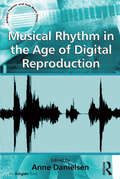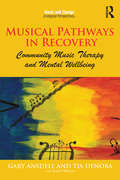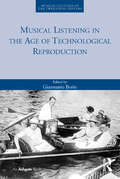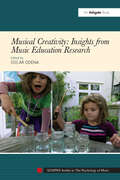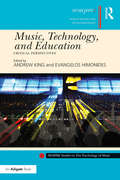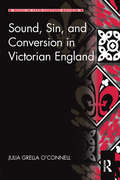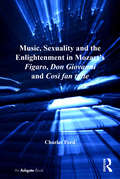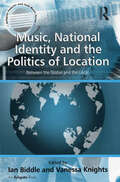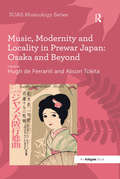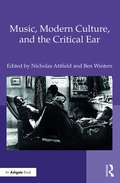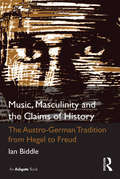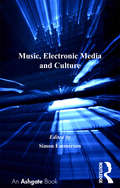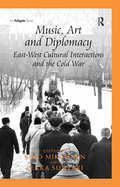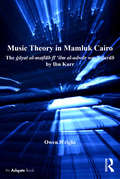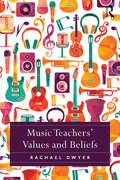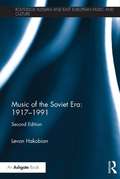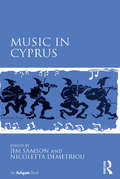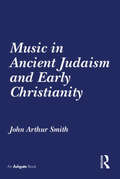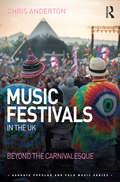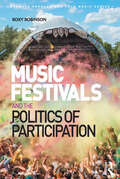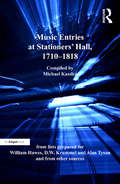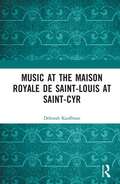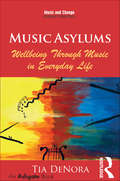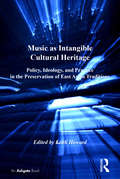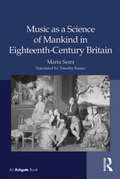- Table View
- List View
Musical Rhythm in the Age of Digital Reproduction (Ashgate Popular and Folk Music Series)
by Anne DanielsenMusical Rhythm in the Age of Digital Reproduction presents new insights into the study of musical rhythm through investigations of the micro-rhythmic design of groove-based music. The main purpose of the book is to investigate how technological mediation - in the age of digital music production tools - has influenced the design of rhythm at the micro level. Through close readings of technology-driven popular music genres, such as contemporary R&B, hip-hop, trip-hop, electro-pop, electronica, house and techno, as well as played folk music styles, the book sheds light on how investigations of the musical-temporal relationships of groove-based musics might be fruitfully pursued, in particular with regard to their micro-rhythmic features. This book is based on contributions to the project Rhythm in the Age of Digital Reproduction (RADR), a five-year research project running from 2004 to 2009 that was funded by the Norwegian Research Council.
Musical Pathways in Recovery: Community Music Therapy and Mental Wellbeing (Music and Change: Ecological Perspectives)
by Gary Ansdell Tia DeNora"Music triggered a healing process from within me. I started singing for the joy of singing myself and it helped me carry my recovery beyond the state I was in before I fell ill nine years ago to a level of well-being that I haven't had perhaps for thirty years." This book explores the experiences of people who took part in a vibrant musical community for people experiencing mental health difficulties, SMART (St Mary Abbotts Rehabilitation and Training). Ansdell (a music therapist/researcher) and DeNora (a music sociologist) describe their long-term ethnographic work with this group, charting the creation and development of a unique music project that won the 2008 Royal Society for Public Health Arts and Health Award. Ansdell and DeNora track the 'musical pathways' of a series of key people within SMART, focusing on changes in health and social status over time in relation to their musical activity. The book includes the voices and perspectives of project members and develops with them a new understanding of how music promotes their health and wellbeing. A contemporary ecological understanding of 'music and change' is outlined, drawing on and further developing theory from music sociology and Community Music Therapy. This innovative book will be of interest to anyone working in the mental health field, but also music therapists, sociologists, musicologists, music educators and ethnomusicologists. This volume completes a three part 'triptych', alongside the other volumes, Music Asylums: Wellbeing Through Music in Everyday Life, and How Music Helps: In Music Therapy and Everyday Life.
Musical Listening in the Age of Technological Reproduction (Musical Cultures of the Twentieth Century)
by Gianmario BorioIt is undeniable that technology has made a tangible impact on the nature of musical listening. The new media have changed our relationship with music in a myriad of ways, not least because the experience of listening can now be prolonged at will and repeated at any time and in any space. Moreover, among the more striking social phenomena ushered in by the technological revolution, one cannot fail to mention music’s current status as a commodity and popular music’s unprecedented global reach. In response to these new social and perceptual conditions, the act of listening has diversified into a wide range of patterns of behaviour which seem to resist any attempt at unification. Concentrated listening, the form of musical reception fostered by Western art music, now appears to be but one of the many ways in which audiences respond to organized sound. Cinema, for example, has developed specific ways of combining images and sounds; and, more recently, digital technology has redefined the standard forms of mass communication. Information is aestheticized, and music in turn is incorporated into pre-existing symbolic fields. This volume - the first in the series Musical Cultures of the Twentieth Century - offers a wide-ranging exploration of the relations between sound, technology and listening practices, considered from the complementary perspectives of art music and popular music, music theatre and multimedia, composition and performance, ethnographic and anthropological research.
Musical Creativity: Insights From Music Education Research (SEMPRE Studies in The Psychology of Music)
by Oscar OdenaHow do we develop musical creativity? How is musical creativity nurtured in collaborative improvisation? How is it used as a communicative tool in music therapy? This comprehensive volume offers new research on these questions by an international team of experts from the fields of music education, music psychology and music therapy. The book celebrates the rich diversity of ways in which learners of all ages develop and use musical creativity. Contributions focus broadly on the composition/improvisation process, considering its conceptualization and practices in a number of contexts. The authors examine how musical creativity can be fostered in formal settings, drawing examples from primary and secondary schools, studio, conservatoire and university settings, as well as specialist music schools and music therapy sessions. These essays will inspire readers to think deeply about musical creativity and its development. The book will be of crucial interest to music educators, policy makers, researchers and students, as it draws on applied research from across the globe, promoting coherent and symbiotic links between education, music and psychology research.
Music, Technology, and Education: Critical Perspectives (SEMPRE Studies in The Psychology of Music)
by Andrew King Evangelos HimonidesThe use of technology in music and education can no longer be described as a recent development. Music learners actively engage with technology in their music making, regardless of the opportunities afforded to them in formal settings. This volume draws together critical perspectives in three overarching areas in which technology is used to support music education: music production; game technology; musical creation, experience and understanding. The fourteen chapters reflect the emerging field of the study of technology in music from a pedagogical perspective. Contributions come not only from music pedagogues but also from musicologists, composers and performers working at the forefront of the domain. The authors examine pedagogical practice in the recording studio, how game technology relates to musical creation and expression, the use of technology to create and assess musical compositions, and how technology can foster learning within the field of Special Educational Needs (SEN). In addition, the use of technology in musical performance is examined, with a particular focus on the current trends and the ways it might be reshaped for use within performance practice. This book will be of value to educators, practitioners, musicologists, composers and performers, as well as to scholars with an interest in the critical study of how technology is used effectively in music and music education.
Sound, Sin, and Conversion in Victorian England (Music in Nineteenth-Century Britain)
by Julia Grella O'ConnellThe plight of the fallen woman is one of the salient themes of nineteenth-century art and literature; indeed, the ubiquity of the trope galvanized the Victorian conscience and acted as a spur to social reform. In some notable examples, Julia Grella O’Connell argues, the iconography of the Victorian fallen woman was associated with music, reviving an ancient tradition conflating the practice of music with sin and the abandonment of music with holiness. The prominence of music symbolism in the socially-committed, quasi-religious paintings of the Pre-Raphaelites and their circle, and in the Catholic-Wagnerian novels of George Moore, gives evidence of the survival of a pictorial language linking music with sin and conversion, and shows, even more remarkably, that this language translated fairly easily into the cultural lexicon of Victorian Britain. Drawing upon music iconography, art history, patristic theology, and sensory theory, Grella O’Connell investigates female fallenness and its implications against the backdrop of the social and religious turbulence of the mid-nineteenth century.
Music, Sexuality and the Enlightenment in Mozart's Figaro, Don Giovanni and Così fan tutte
by Charles FordMusic, Sexuality and the Enlightenment explains how Mozart's music for Le nozze di Figaro, Don Giovanni and Così fan tutte 'sounds' the intentions of Da Ponte's characters and their relationships with one another. Mozart, by way of the infinitely generative and beautiful logic of the sonata principle, did not merely interpret Da Ponte's characterizations but lent them temporal, musical forms. Charles Ford's analytic interpretation of these musical forms concerns processes and structures in detail and at medium- to long-term levels. He addresses the music of a wide range of arias and ensembles, and develops original ways to interpret the two largely overlooked operatic genres of secco recitative and finales. Moreover, Ford presents a new method by which to relate musical details directly to philosophical concepts, and thereby, the music of the operas to the inwardly contradictory thinking of the European Enlightenment. This involves close readings of late eighteenth-century understandings of 'man' and nature, self and other, morality and transgression, and gendered identities and sexuality, with particular reference to contemporary writers, especially Goethe, Kant, Laclos, Rousseau, Sade, Schiller, Sterne and Wollstonecraft. The concluding discussion of the implied futures of the operas argues that their divided sexualities, which are those of the Enlightenment as a whole, have come to form our own unquestioned assumptions about gender differences and sexuality. This, along with the elegant and eloquent precision of Mozart's music, is why Figaro, Giovanni and Così still maintain their vital immediacy for audiences today.
Music, National Identity and the Politics of Location: Between the Global and the Local (Ashgate Popular and Folk Music Series)
by Vanessa KnightsHow are national identities constructed and articulated through music? Popular music has long been associated with political dissent, and the nation state has consistently demonstrated a determination to seek out and procure for itself a stake in the management of 'its' popular musics. Similarly, popular musics have been used 'from the ground up' as sites for both populist and popular critiques of nationalist sentiment, from the position of both a globalizing and a 'local' vernacular culture. The contributions in this book arrive at a critical moment in the development of the study of national cultures and musicology. The book ranges from considerations of the ideological focus of cultural nationalism through to analyses of musical hybridity and musical articulations of other kinds of identities at odds with national identity. The processes of global homogenization are thereby shown to have brought about a transitional crisis for national cultural identities: the evolution of these identities, particularly with reference to the concept of 'authenticity' in music, is situated within broader debates on power, political economy and constructions of the self. Theorizations of practice are employed after the manner of Bourdieu, Gramsci, Goffman, Gadamer, Habermas, Bhabha, Lacan and Zizek. Each contribution acts as a case study to characterize the strategies through which differing modes of musical discourse engage, critique or obscure discourses on national identity. The studies include discussions of: musical representations of Irishness; the relationship between Afropop and World Music; Norwegian club music; the revival of traditional music in Serbia; resistance to cultural homogeneity in Brazil; contemporary Uyghur song in Northwest China; rap and race in French society; technobanda from the barrios of Los Angeles, and Spanish/Moroccan raï. In this way, the book seeks to characterize the ideological configurations that help to activate and sustain hegemonic, amb
Music, Modernity and Locality in Prewar Japan: Osaka And Beyond (SOAS Studies in Music Series)
by Hugh De Ferranti Alison TokitaThis anthology addresses the modern musical culture of interwar Osaka and its surrounding Hanshin region. Modernity as experienced in this locale, with its particular historical, geographic and demographic character, and its established traditions of music and performance, gave rise to configurations of the new, the traditional and the hybrid that were distinct from their Tokyo counterparts. The Taisho and early Showa periods, from 1912 to the early 1940s, saw profound changes in Japanese musical life. Consumption of both traditional Japanese and Western music was transformed as public concert performances, music journalism, and music marketing permeated daily life. The new bourgeoisie saw Western music, particularly the piano and its repertoire, as the symbol of a desirable and increasingly affordable modernity. Orchestras and opera troupes were established, which in turn created a need for professional conductors, and both jazz and a range of hybrid popular music styles became viable bases for musical livelihood. Recording technology proliferated; by the early 1930s, record players and SP discs were no longer luxury commodities, radio broadcasts reached all levels of society, and ’talkies’ with music soundtracks were avidly consumed. With the perceived need for music that suited 'modern life', the seeds for the pre-eminent position of Euro-American music in post-Second-World war Japan were sown. At the same time many indigenous musical genres continued to thrive, but were hardly immune to the effects of modernization; in exploring new musical media and techniques drawn from Western music, performer-composers initiated profound changes in composition and performance practice within traditional genres. This volume is the first to draw together research on the interwar musical culture of the Osaka region and addresses comprehensively both Western and non-Western musical practices and genres, questions the common perception of their being wholly separate domains
Music, Modern Culture, and the Critical Ear
by Nicholas Attfield Ben WintersIn his 1985 book The Idea of Music: Schoenberg and Others, Peter Franklin set out a challenge for musicology: namely, how best to talk and write about the music of modern European culture that fell outside of the modernist mainstream typified by Schoenberg, Berg, and Webern? Thirty years on, this collected volume of essays by Franklin’s students and colleagues returns to that challenge and the vibrant intellectual field that has since developed. Moving freely between insights into opera, Volksoper, film, festival, and choral movement, and from the very earliest years of the twentieth century up to the 1980s, its authors listen with a ‘critical ear’: they site these musical phenomena within a wider web of modern cultural practices - a perspective, in turn, that enables them to exercise a disciplinary self-awareness after Franklin’s manner.
Music, Masculinity and the Claims of History: The Austro-German Tradition from Hegel to Freud
by Ian BiddleWhat does it mean to think of Western Art music - and the Austro-German contribution to that repertory - as a tradition? How are men and masculinities implicated in the shaping of that tradition? And how is the writing of the history (or histories) of that tradition shaped by men and masculinities? This book seeks to answer these and other questions by drawing both on a wide range of German-language writings on music, sound and listening from the so-called long nineteenth century (circa 1800-1918), and a range of critical-theoretical texts from the post-war continental philosophical and psychoanalytic traditions, including Lacan, Zizek, Serres, Derrida and Kittler. The book is focussed in particular on bringing the object of historical writing itself into scrutiny by engaging in what Zizek has called a 'historicity' or a way of writing about the past that not merely acknowledges the ahistorical kernel of historical writing, but brings that kernel into the light of day, takes account of it and puts it into play. The book is thus committed to a kind of historical writing that is open-ended - though not ideologically naïve - and that does not fix or stabilize the nature of the relationship between so-called 'primary' and 'secondary' texts. The book consists of an introduction, which places the study of classical music and the Austro-German tradition within broader debates about the value of that tradition, and four extensive case studies: an analysis of the cultural-historical category of listening around 1800; a close reading of A. B. Marx's Beethoven monograph of 1859; a consideration of Heinrich Schenker's attitudes to the mob and the vernacular more broadly and an examination, through Franz Kafka, of the figure of Mahler's body.
Music, Electronic Media and Culture
by Simon EmmersonTechnology revolutionised the ways that music was produced in the twentieth century. As that century drew to a close and a new century begins a new revolution in roles is underway. The separate categories of composer, performer, distributor and listener are being challenged, while the sounds of the world itself become available for musical use. All kinds of sounds are now brought into the remit of composition, enabling the music of others to be sampled (or plundered), including that of unwitting musicians from non-western cultures. This sound world may appear contradictory - stimulating and invigorating as well as exploitative and destructive. This book addresses some of the issues now posed by the brave new world of music produced with technology.
Music, Art and Diplomacy: East-west Cultural Interactions And The Cold War
by Simo Mikkonen Pekka SuutariMusic, Art and Diplomacy shows how a vibrant field of cultural exchange between East and West was taking place during the Cold War, which contrasts with the orthodox understanding of two divided and antithetical blocs. The series of case studies on cultural exchanges, focusing on the decades following the Second World War, cover episodes involving art, classical music, theatre, dance and film. Despite the fluctuating fortunes of diplomatic relations between East and West, there was a continuous circulation of cultural producers and products. Contributors explore the interaction of arts and politics, the role of the arts in diplomacy and the part the arts played in the development of the Cold War. Art has always shunned political borders, wavering between the guidance of individual and governmental patrons, and borderless expression. While this volume provides insight into how political players tried to harness the arts to serve their own political purposes, at the same time it is clear that the arts and artists exploited the Cold War framework to reach their own individual and professional objectives. Utilizing archives available only since the collapse of the Soviet Union, the volume provides a valuable socio-cultural approach to understanding the Cold War and cultural diplomacy.
Music Theory in Mamluk Cairo: The ġāyat al-maṭlūb fī ‘ilm al-adwār wa-’l-ḍurūb by Ibn Kurr (SOAS Studies in Music)
by Owen WrightThe ġāyat al-maṭlūb fī ‘ilm al-adwār wa-'l-ḍurūb by Ibn Kurr is the only theoretical text of any substance that can be considered representative of musicological discourse in Cairo during the first half of the fourteenth century CE. Indeed, nothing comparable survives from the whole Mamluk period, which extends from 1260 until the Ottoman invasion and conquest of Egypt in 1516. But its value does not derive merely from its fortuitous isolation: it is important, rather, because of the richness of the information it provides with regard to modal and rhythmic structures, and also because of the extent to which the definitions it offers differ from those set forth in an interrelated series of major theoretical works in both Arabic and Persian that span the period from the middle of the thirteenth century to the late fifteenth. Alongside the presumption of transregional uniformity these texts suggest, it consequently asserts the significance of local particularism. Owen Wright provides a critical edition of the text itself, together with a glossary, prefaced by an introduction and a detailed commentary and analysis. The introduction provides immediate context, situating the work in relation to the dominant theoretical tradition of the period and providing biographical information about the author, active in Cairo during the first half of the fourteenth century.
Music Teachers' Values and Beliefs
by Rachael DwyerIn Music Teachers' Values and Beliefs, Dwyer investigates the relationships between teachers, learners and music in music classrooms. Using Bourdieu's concepts of habitus and doxa as an interpretive lens, the book explores the values and beliefs of four music teachers, depicted in richly detailed narratives. The narratives are contextualised through the examination of traditions of music and contemporary approaches. In the past, music education has been shaped by elitist tendencies regarding the types of music worthy of study, the ways in which music should be learnt, and the purpose of such learning. Contemporary approaches to music education have enacted significant change in some regions and systems, while others have been slower to leave behind deeply entrenched values, beliefs and practices. These approaches have been blamed for low rates of participation and engagement in school music education, despite the fact that the majority of young people listen to and enjoy music outside of school. This innovative book provides music education researchers and practitioners with a new understanding of the impact of teachers' personal values, beliefs and experiences of music and music education on classroom practice, and the impact this has on students' experiences of music education.
Music of the Soviet Era: 2nd Edition (Routledge Russian and East European Music and Culture)
by Levon HakobianThis volume is a comprehensive and detailed survey of music and musical life of the entire Soviet era, from 1917 to 1991, which takes into account the extensive body of scholarly literature in Russian and other major European languages. In this considerably updated and revised edition of his 1998 publication, Hakobian traces the strikingly dramatic development of the music created by outstanding and less well-known, ‘modernist’ and ‘conservative’, ‘nationalist’ and ‘cosmopolitan’ composers of the Soviet era. The book’s three parts explore, respectively, the musical trends of the 1920s, music and musical life under Stalin, and the so-called ’Bronze Age’ of Soviet music after Stalin’s death. Music of the Soviet Era: 1917–1991 considers the privileged position of music in the USSR in comparison to the written and visual arts. Through his examination of the history of the arts in the Soviet state, Hakobian’s work celebrates the human spirit’s wonderful capacity to derive advantage even from the most inauspicious conditions.
Music in Cyprus
by Jim Samson Nicoletta DemetriouMusic in Cyprus draws its authors from both sides of the divided island to give a rounded picture of musical culture from the beginning of the British colonial period (1878-1960) until today. The book crosses conventional scholarly divides between musicology and ethnomusicology in order to achieve a panorama of music, culture and politics. Shared practices of traditional music and dance are outlined, and the appropriation of those practices by both communities in the aftermath of the de facto division of the island is examined. Art music (European and Ottoman) is also discussed, both in terms of the structures of musical life and the creative praxes of composers, and there is an account of the early stages of a popular music industry. The authors consider such questions as: What is the role of different musics in defining national, regional, social and cultural identities in Cyprus? How do Cypriot alterities illuminate European projects of modernity? And what has been the impact of westernization and modernization (and, conversely, of orientalization) on music in Cyprus? The book will be of interest to students and academics working not only in both historical musicology and ethnomusicology, but also in the history and anthropology of Cyprus and of the entire Greek-Anatolian region.
Music in Ancient Judaism and Early Christianity
by John Arthur SmithIn Music in Ancient Judaism and Early Christianity, John Arthur Smith presents the first full-length study of music among the ancient Israelites, the ancient Jews and the early Christians in the Mediterranean lands during the period from 1000 BCE to 400 CE. He considers the physical, religious and social setting of the music, and how the music was performed. The extent to which early Christian music may have retained elements of the musical tradition of Judaism is also considered. After reviewing the subject's historical setting, and describing the main sources, the author discusses music at the Jerusalem Temple and in a variety of spheres of Jewish life away from it. His subsequent discussion of early Christian music covers music in private devotion, monasticism, the Eucharist, and gnostic literature. He concludes with an examination of the question of the relationship between Jewish and early Christian music, and a consideration of the musical environments that are likely to have influenced the formation of the earliest Christian chant. The scant remains of notated music from the period are discussed and placed in their respective contexts. The numerous sources that are the foundation of the book are evaluated objectively and critically in the light of modern scholarship. Due attention is given to where their limitations lie, and to what they cannot tell us as well as to what they can. The book serves as a reliable introduction as well as being an invaluable guide through one of the most complex periods of music history.
Music Festivals in the UK: Beyond the Carnivalesque (Ashgate Popular and Folk Music Series)
by Chris AndertonThe outdoor music festival market has developed and commercialised significantly since the mid-1990s, and is now a mainstream part of the British summertime leisure experience. The overall number of outdoor music festivals staged in the UK doubled between 2005 and 2011 to reach a peak of over 500 events. UK Music (2016) estimates that the sector attracts over 3.7 million attendances each year, and that music tourism as a whole sustains nearly 40,000 full-time jobs. Music Festivals in the UK is the first extended investigation into this commercialised rock and pop festival sector, and examines events of all sizes: from mega-events such as Glastonbury Festival, V Festival and the Reading and Leeds Festivals to ‘boutique’ events with maximum attendances as small as 250. In the past, research into festivals has typically focused either on their carnivalesque heritage or on developing managerial tools for the field of Events Management. Anderton moves beyond such perspectives to propose new ways of understanding and theorising the cultural, social and geographic importance of outdoor music festivals. He argues that changes in the sector since the mid-1990s, such as professionalisation, corporatisation, mediatisation, regulatory control, and sponsorship/branding, should not necessarily be regarded as a process of transgressive 'alternative culture’ being co-opted by commercial concerns; instead, such changes represent a reconfiguration of the sector in line with changes in society, and a broadening of the forms and meanings that may be associated with outdoor music events.
Music Festivals and the Politics of Participation (Ashgate Popular and Folk Music Series)
by Roxy RobinsonThe spread of UK music festivals has exploded since 2000. In this major contribution to cultural studies, the lid is lifted on the contemporary festival scene. Gone are the days of a handful of formulaic, large events dominating the market place. Across the country, hundreds of ’boutique’ gatherings have popped up, drawing hundreds of thousands of festival-goers into the fields. Why has this happened? What has led to this change? In her richly detailed study, industry insider Dr Roxy Robinson uncovers the dynamics that have led to the formation and evolution of the modern festival scene. Tracing the history of the culture as far back as the fifties, this book examines the tensions between authenticity and commerce as festivals grew into a widespread, professionalized industry. Setting the scene as a fragmented, yet highly competitive market, Music Festivals and the Politics of Participation examines the emergence of key trends with a focus on surrealist production and popular theatricality. For the first time, the transatlantic relationship between British promoters and the social experiment-come-festival Burning Man is documented, uncovering its role in promoting a politics of participation that has dramatically altered the festival experience. Taking an in-depth approach to examining key events, including the fastest growing independent music festival in recent years (Hampshire’s BoomTown Fair) the UK market is shown to have produced a scene that champions co-production and the democratization of festival space. This is a vital text for anyone interested in British culture.
Music Entries at Stationers' Hall, 1710–1818: from lists prepared for William Hawes, D.W. Krummel and Alan Tyson and from other sources
by Michael KasslerThe British Copyright Act of 1709 protected proprietors of books and music printed after 10 April 1710 who gave copies to the Company of Stationers in London. Upon receipt of a copy, usually within days of its first publication, the Stationers' Hall warehouse keeper entered details into a register. They included the date of registration, the name of the work's proprietor (its author or, if copyright had been transferred, its publisher), and the work's full title, which normally named the composer and the writer of any text and often named the work's performers and dedicatee. Although some publishers put the words 'Entered at Stationers' Hall' on title-pages without actually depositing copies, the information in the registers about the many works that were registered has significant bibliographic value. Because the music entries have not previously been printed and access to them has been difficult, they generally have been ignored by cataloguers and scholars, with the consequence that numerous musical works of this period have been misdated in libraries and reference books. This book makes available, for the first time, the full text of the music entries at Stationers' Hall from 1710 to 1810 and abbreviated details of works entered from 1811 to 1818. Its value is enhanced by the inclusion of locations of copies of most works, together with indexes of composers, authors, performers and dedicatees, and an explanatory introduction by the compiler.
Music at the Maison royale de Saint-Louis at Saint-Cyr
by Deborah KauffmanThe history of music at the Maison royale de Saint-Louis at Saint-Cyr — the famous convent school founded by Madame de Maintenon and established by Louis XIV in 1686 as a royal foundation — is both rich and intriguing; its large repertory of music was composed expressly for young female voices by important composers working within significant contemporary musical genres: liturgical chant, sacred motets, theatrical music, and cantiques spirituels. While these genres reflect contemporary styles and trends, at the same time the works themselves were made to conform to the sensibilities and abilities of their intended performers. Even as Jean-Baptiste Moreau's music for Jean Racine’s biblical tragedies Esther and Athalie shows a number of similarities to contemporary tragédies lyriques, it departs from that more public genre in its brevity, generally simpler solo writing, and the integral use of the chorus. The musical style of the choral numbers closely parallels that of other choral music in the repertory at Saint-Cyr. The liturgical chant sung in the church was composed by Guillaume-Gabriel Nivers, and is an example of plain-chant musical, a type of new ecclesiastical composition written during the seventeenth and eighteenth centuries, primarily for female religious communities in France. The large repertory of petits motets (short sacred Latin pieces for solo voice), mostly composed by Nivers and Louis-Nicolas Clérambault, are simpler and more restrained than works by their contemporaries. A close study of the motets reveals much about changes to musical style and performance practices at Saint-Cyr during the eighteenth century. The cantique spirituel, a song with a spiritual text in the vernacular French language, played a significant role in both the education and recreation of the girls at Saint-Cyr. Cantiques composed for the girls vary widely in terms of their style and difficulty, ranging from simple strophic melodies to more sophisticated works in the style of contemporary airs. In all cases, the stylistic features of the music for Saint-Cyr reflect a careful consideration of the needs and capabilities of the young singers of the school, as well as an awareness of the rigorous requirements of Madame de Maintenon, who kept a close watch over the propriety of all things relating to the piety, behavior, and image of her charges.
Music Asylums: Wellbeing Through Music In Everyday Life (Music and Change: Ecological Perspectives)
by Tia DeNoraTaking a cue from Erving Goffman’s classic work, Asylums, Tia DeNora develops a novel interdisciplinary framework for music, health and wellbeing. Considering health and illness both in medical contexts and in the often-overlooked realm of everyday life, DeNora argues that these identities are by no means mutually exclusive. Moreover, she suggests that the promotion of health and more specifically, mental health, involves a great deal more than a concern with medication, genetic predispositions, clinical and neuro-scientific procedures. Adopting a holistic, interactionist focus, Music Asylums reconnects states of wellness and wellbeing to encounters with others and - critically - to opportunities for aesthetic experience. Building on DeNora's earlier work on music as a technology of self in everyday life, the book presents music as an active ingredient of action, identity, capacity and consciousness. From there, it suggests that access to, and evaluation of, music is an important ethical matter. Intended for scholars and practitioners in psychiatry and psychology, palliative care, socio-music studies, music psychology and the allied health professions, Music Asylums showcases music's role in the existential project of being and staying well, mentally and physically, from moment-to-moment and across all realms of social life.
Music as Intangible Cultural Heritage: Policy, Ideology, and Practice in the Preservation of East Asian Traditions (SOAS Studies in Music Series)
by Keith HowardFocussing on music traditions, these essays explore the policy, ideology and practice of preservation and promotion of East Asian intangible cultural heritage. For the first time, Japan, Korea, China and Taiwan - states that were amongst the first to establish legislation and systems for indigenous traditions - are considered together. Calls to preserve the intangible heritage have recently become louder, not least with increasing UNESCO attention. The imperative to preserve is, throughout the region, cast as a way to counter the perceived loss of cultural diversity caused by globalization, modernization, urbanization and the spread of the mass media. Four chapters - one each on China, Korea, Taiwan and Japan - incorporate a foundational overview of preservation policy and practice of musical intangible cultural heritage at the state level. These chapters are complemented by a set of chapters that explore how the practice of policy has impacted on specific musics, from Confucian ritual through Kam big song to the Okinawan sanshin. Each chapter is based on rich ethnographic data collected through extended fieldwork. The team of international contributors give both insider and outsider perspectives as they both account for, and critique, policy, ideology and practice in East Asian music as intangible cultural heritage.
Music as a Science of Mankind in Eighteenth-Century Britain
by Maria Semi translated by KeatesMusic as a Science of Mankind offers a philosophical and historical perspective on the intellectual representation of music in British eighteenth-century culture. From the field of natural philosophy, involving the science of sounds and acoustics, to the realm of imagination, involving resounding music and art, the branches of modern culture that were involved in the intellectual tradition of the science of music proved to be variously appealing to men of letters. Among these, a particularly rich field of investigation was the British philosophy of the mind and of human understanding, developed between the seventeenth and eighteenth centuries, which looked at music and found in its realm a way of understanding human experience. Focussing on the world of sensation - trying to describe how the human mind could develop ideas and emotions by its means - philosophers and physicians often took their cases from art's products, be it music (sounds), painting (colours) or poetry (words as signs of sound conveying a meaning), thus looking at art from a particular point of view: that of the perceiving mind. The relationship between music and the philosophies of mind is presented here as a significant part of the construction of a Science of Man: a huge and impressive 'project' involving both the study of man's nature, to which - in David Hume's words - 'all sciences have a relation', and the creation of an ideal of what Man should be. Maria Semi sheds light on how these reflections moved towards a Science of Music: a complex and articulated vision of the discipline that was later to be known as 'musicology'; or Musikwissenschaft.
